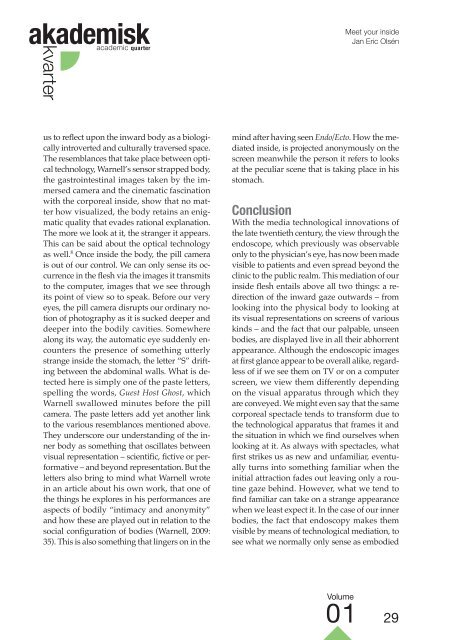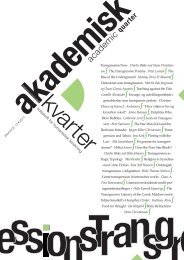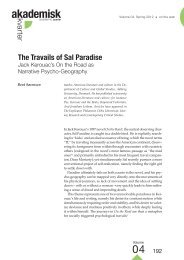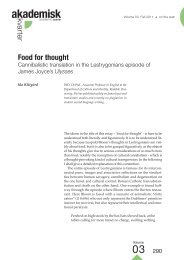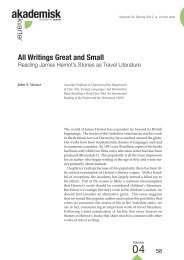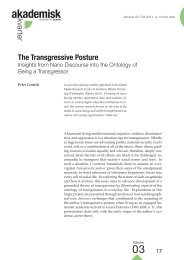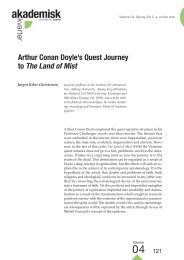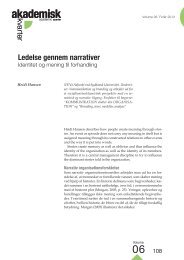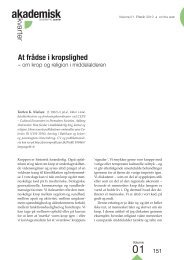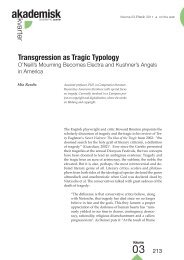Academic Quarter - Akademisk kvarter
Academic Quarter - Akademisk kvarter
Academic Quarter - Akademisk kvarter
Create successful ePaper yourself
Turn your PDF publications into a flip-book with our unique Google optimized e-Paper software.
akademiskacademic quarter<strong>kvarter</strong>Meet your insideJan Eric Olsénus to reflect upon the inward body as a biologicallyintroverted and culturally traversed space.The resemblances that take place between opticaltechnology, Warnell’s sensor strapped body,the gastrointestinal images taken by the immersedcamera and the cinematic fascinationwith the corporeal inside, show that no matterhow visualized, the body retains an enigmaticquality that evades rational explanation.The more we look at it, the stranger it appears.This can be said about the optical technologyas well. 8 Once inside the body, the pill camerais out of our control. We can only sense its occurrencein the flesh via the images it transmitsto the computer, images that we see throughits point of view so to speak. Before our veryeyes, the pill camera disrupts our ordinary notionof photography as it is sucked deeper anddeeper into the bodily cavities. Somewherealong its way, the automatic eye suddenly encountersthe presence of something utterlystrange inside the stomach, the letter “S” driftingbetween the abdominal walls. What is detectedhere is simply one of the paste letters,spelling the words, Guest Host Ghost, whichWarnell swallowed minutes before the pillcamera. The paste letters add yet another linkto the various resemblances mentioned above.They underscore our understanding of the innerbody as something that oscillates betweenvisual representation – scientific, fictive or performative– and beyond representation. But theletters also bring to mind what Warnell wrotein an article about his own work, that one ofthe things he explores in his performances areaspects of bodily “intimacy and anonymity”and how these are played out in relation to thesocial configuration of bodies (Warnell, 2009:35). This is also something that lingers on in themind after having seen Endo/Ecto. How the mediatedinside, is projected anonymously on thescreen meanwhile the person it refers to looksat the peculiar scene that is taking place in hisstomach.ConclusionWith the media technological innovations ofthe late twentieth century, the view through theendoscope, which previously was observableonly to the physician’s eye, has now been madevisible to patients and even spread beyond theclinic to the public realm. This mediation of ourinside flesh entails above all two things: a redirectionof the inward gaze outwards – fromlooking into the physical body to looking atits visual representations on screens of variouskinds – and the fact that our palpable, unseenbodies, are displayed live in all their abhorrentappearance. Although the endoscopic imagesat first glance appear to be overall alike, regardlessof if we see them on TV or on a computerscreen, we view them differently dependingon the visual apparatus through which theyare conveyed. We might even say that the samecorporeal spectacle tends to transform due tothe technological apparatus that frames it andthe situation in which we find ourselves whenlooking at it. As always with spectacles, whatfirst strikes us as new and unfamiliar, eventuallyturns into something familiar when theinitial attraction fades out leaving only a routinegaze behind. However, what we tend tofind familiar can take on a strange appearancewhen we least expect it. In the case of our innerbodies, the fact that endoscopy makes themvisible by means of technological mediation, tosee what we normally only sense as embodiedVolume01 29


